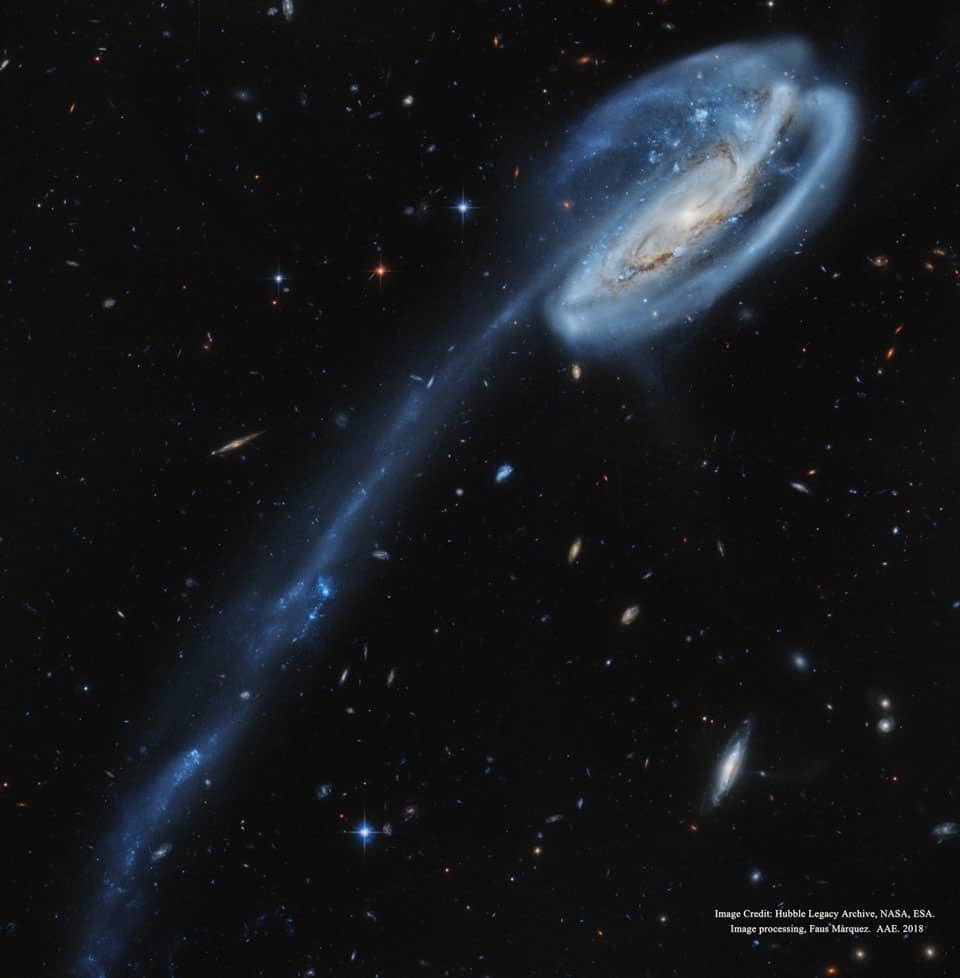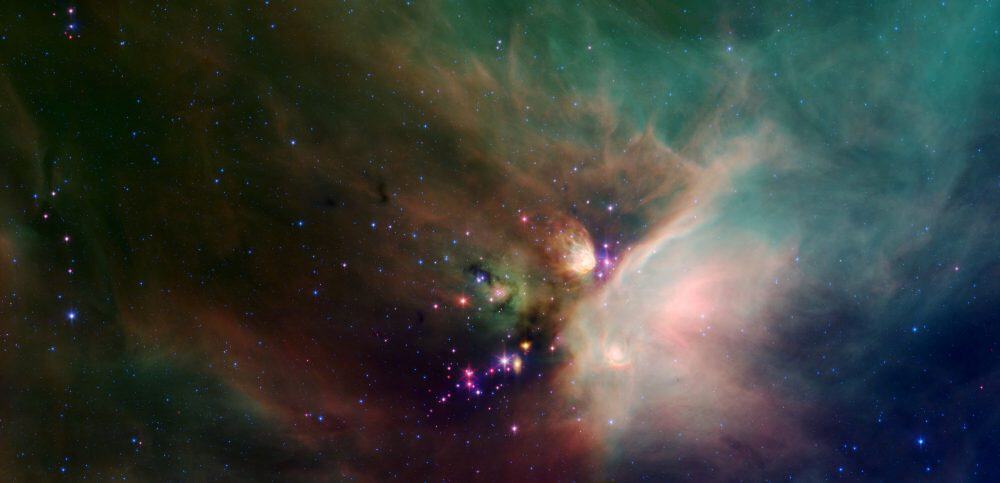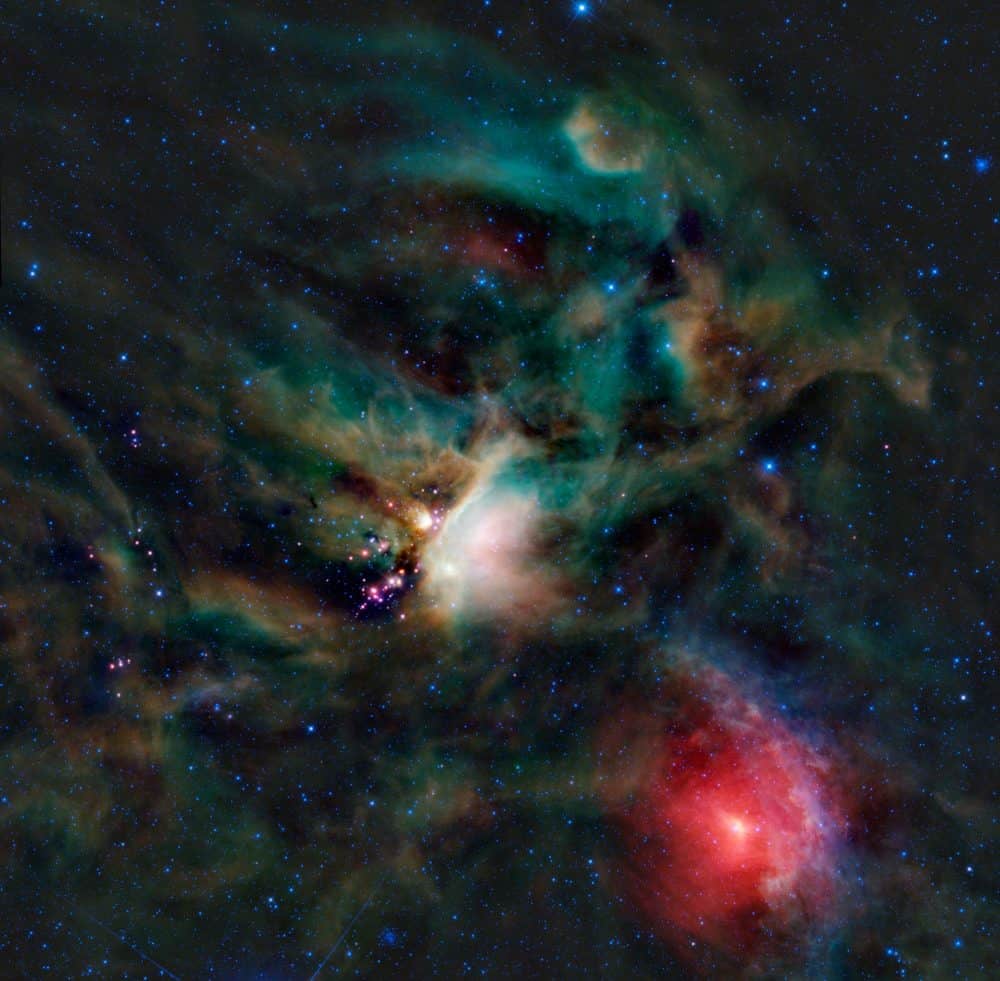Blog
Why does this galaxy have such a long tail? In this stunning vista, based on image data from the Hubble Legacy Archive, distant galaxies form a dramatic backdrop for disrupted spiral galaxy Arp 188, the Tadpole Galaxy. The cosmic tadpole is a mere 420 million light-years distant toward the northern constellation of the Dragon (Draco). Its eye-catching tail is about 280 thousand light-years long and features massive, bright blue star clusters. One story goes that a more compact intruder galaxy crossed in front of Arp 188 – from right to left in this view – and was slung around behind the Tadpole by their gravitational attraction. During the close encounter, tidal forces drew out the spiral galaxy’s stars, gas, and dust forming the spectacular tail. The intruder galaxy itself, estimated to lie about 300 thousand light-years behind the, can be seen through foreground spiral arms at the upper right. Following its terrestrial namesake, the Tadpole Galaxy will likely lose its tail as it grows older, the tail’s star clusters forming smaller satellites of the large spiral galaxy.
more...Alfred McCoy Tyner (born December 11, 1938) is a jazz pianist from Philadelphia known for his work with the John Coltrane Quartet and a long solo career.
Tyner was born in Philadelphia as the oldest of three children. He was encouraged to study piano by his mother. He began studying the piano at age 13 and within two years music had become the focal point in his life. When he was 17, he converted to Islam through the Ahmadiyya Muslim Community and changed his name to Sulieman Saud. His neighbors in Philadelphia included musicians Richie Powell and Bud Powell.
Tyner started his career in 1960 as a member of the Jazztet led by Benny Golson and Art Farmer. Six months later, he joined the quartet of John Coltrane that included Jimmy Garrison and Elvin Jones. He worked with the band during its extended run at the Jazz Gallery, replacing Steve Kuhn(Coltrane had known Tyner for a while in Philadelphia, and performed one of the pianist’s compositions, “The Believer”, as early as 1958). He played on Coltrane’s “My Favorite Things” for Atlantic. The band toured almost non-stop between 1961 and 1965, recording the albums Live! at the Village Vanguard, Ballads, Live at Birdland, Crescent, A Love Supreme, and The John Coltrane Quartet Plays for Impulse!.
While in Coltrane’s group, he recorded albums as a leader in a piano trio. He also appeared as a sideman on many Blue Note albums of the 1960s, although he was often credited as “etc.” on the cover of these albums to respect his contract with Impulse! Records.
more...Willie Mae Thornton (December 11, 1926 – July 25, 1984) better known as Big Mama Thornton, was an American rhythm-and-blues singer and songwriter. She was the first to record Leiber and Stoller’s “Hound Dog“, in 1952, which became her biggest hit, staying seven weeks at number one on the Billboard R&B chart in 1953 and selling almost two million copies. Thornton’s other recordings included the original version of “Ball ‘n’ Chain“, which she wrote.
Thornton’s performances were characterized by her deep, powerful voice and strong sense of self. She was given her nickname, “Big Mama,” by Frank Schiffman, the manager of Harlem’s Apollo Theater, because of her strong voice, size, and personality. Thornton stated that she was louder than any microphone and didn’t want a microphone to ever be as loud as she was. Alice Echols, the author of a biography of Janis Joplin, said that Thornton could sing in a “pretty voice” but did not want to. Thornton said, “My singing comes from my experience… My own experience. I never had no one teach me nothin’. I never went to school for music or nothin’. I taught myself to sing and to blow harmonica and even to play drums by watchin’ other people! I can’t read music, but I know what I’m singing! I don’t sing like nobody but myself.
more...Dámaso Pérez Prado (Spanish: [ˈpeɾes ˈpɾaðo]; December 11, 1916 – September 14, 1989) was a Cuban bandleader, organist, pianist and composerwho also made brief appearances in films. He is often referred to as the “King of the Mambo“. He became known and professionally billed as Pérez Prado, his paternal and maternal surnames respectively.
Pérez Prado became a naturalized citizen of Mexico in 1980. His orchestra was the most popular in mambo. His son, Pérez Prado, Jr., continues to direct the Pérez Prado Orchestra in Mexico City to this day.
Pérez was born in Matanzas, Cuba on December 11, 1916; his mother Sara Prado was a school teacher, his father Pablo Pérez a journalist at El Heraldo de Cuba. He studied classical piano in his early childhood, and later played organ and piano in local clubs. For a time, he was pianist and arranger for the Sonora Matancera, Cuba’s best-known musical group at the time. He also worked with casino orchestras in Havana for most of the 1940s. He was nicknamed “El Cara de Foca” (“Seal Face”) by his peers at the time.
more...https://www.youtube.com/watch?v=dDdi6bn06bo
more...Cosmic dust clouds and embedded newborn stars glow at infrared wavelengths in this tantalizing false-color view from the Spitzer Space Telescope. Pictured is of one of the closest star forming regions, part of the Rho Ophiuchi cloud complex some 400 light-years distant near the southern edge of the pronounceable constellation Ophiuchus. The view spans about 5 light-years at that estimated distance. After forming along a large cloud of cold molecular hydrogen gas, newborn stars heat the surrounding dust to produce the infrared glow. An exploration of the region in penetrating infrared light has detected some 300 emerging and newly formed stars whose average age is estimated to be a mere 300,000 years — extremely young compared to the Sun’s age of 5 billion years.
more...Melbourne Robert “Bob” Cranshaw (December 3, 1932 – November 2, 2016) was an American jazz bassist. His career spanned the heyday of Blue Note Records to his recent involvement with the Musicians Union. He is perhaps best known for his long association with Sonny Rollins. Cranshaw performed in Rollins’s working band on and off for over five decades, starting with a live appearance at the 1959 Playboy jazz festival in Chicago and on record with the 1962 album The Bridge.
Some of Cranshaw’s best-known performances include Lee Morgan‘s The Sidewinder and Grant Green‘s Idle Moments. Cranshaw also served as the sole session bassist to Sesame Street and The Electric Company songwriter and composer Joe Raposo, and played bass guitar on all songs, tracks, buttons and cues recorded by the Children’s Television Workshop during Raposo’s tenure. In addition, he was the bass player for Saturday Night Livefrom 1975 to 1980 and musical director and bassist for Dick Cavett’s talk show in the early 1980s. He performed in pit orchestras for numerous Broadway shows including Jesus Christ Superstar, Lena Horne: The Lady and Her Music Sergeant Pepper’s Lonely Heart’s Club Band: The Musical and many more. He recorded innumerable recording dates for television shows, films and jingles. He is among the most recorded bassists in history.
Eddie Jones (December 10, 1926 – February 7, 1959), better known as Guitar Slim, was a New Orleans blues guitarist in the 1940s and 1950s, best known for the million-selling song “The Things That I Used to Do“, produced by Johnny Vincent for Specialty Records. It is listed in the Rock and Roll Hall of Fame’s 500 Songs That Shaped Rock and Roll. Slim had a major impact on rock and roll and experimented with distorted overtones on the electric guitar a full decade before Jimi Hendrix.
Jones was born in Greenwood, Mississippi. His mother died when he was five, and he was raised by his grandmother. In his teen years he worked in cotton fields and spent his free time at juke joints, where he started sitting in as a singer or dancer; he was good enough as a dancer that he was nicknamed “Limber Leg”.
more...Ray Willis Nance (December 10, 1913, in Chicago – January 28, 1976, in New York City) was a jazz trumpeter, violinist and singer. He is best remembered for his long association with Duke Ellington and his orchestra.
Nance was the leader of his own band in Chicago from 1932 to 1937. Then, he worked with Earl Hines from 1937 to 1939; and from 1939 to 1940 he worked with Horace Henderson.
Ellington hired Nance to replace trumpeter Cootie Williams, who had joined Benny Goodman, in 1940. Nance’s first recorded performance with Ellington was at the Fargo, North Dakota ballroom dance.[1] Shortly after joining the band, Nance was given the trumpet solo on the earliest recorded version of “Take the “A” Train“, which became the Ellington theme. Nance’s “A Train” solo is one of the most copied and admired trumpet solos in jazz history. Indeed, when Cootie Williams returned to the band more than twenty years later, he would play Nance’s solo on “A Train” almost exactly as the original.
more...Initially known as a singer and composer of Gospel, Soul and Funk, she gradually incorporated more of her African music in her compositions. In 1994, she recorded her first album Sara Tavares & Shout, released in 1996. To present the album she performed all over Portugal, Cape Verde, and France.
more...The Gould Belt is a partial ring of stars in the Milky Way, about 3000 light years across, tilted toward the galactic plane by about 16 to 20 degrees. It contains many O- and B-type stars, and may represent the local spiral arm to which the Sun belongs—currently the Sun is about 325 light years from the arm’s center. The belt is thought to be from 30 to 50 million years old, and of unknown origin. It is named after Benjamin Gould, who identified it in 1879.
The belt contains bright stars in many constellations including (in order going more or less eastward) Cepheus, Lacerta, Perseus, Orion, Canis Major, Puppis, Vela, Carina, Crux (the Southern Cross), Centaurus, Lupus, and Scorpius (including the Scorpius-Centaurus Association). The Milky Way visible in the sky also passes through most of these constellations, but a bit southeast of Lupus.
more...Jessie Hill (December 9, 1932 – September 17, 1996) was an American R&B and Louisiana blues singer and songwriter, best remembered for the classic song “Ooh Poo Pah Doo”.
Hill was born in New Orleans, Louisiana, United States. By his teens he was playing drums in local bands, and in 1951 he formed his own group, the House Rockers. After periods performing as drummer with Professor Longhair and then Huey “Piano” Smith, Hill formed a new version of the House Rockers in 1958, which enabled him to focus on singing with the band.
The origins of “Ooh Poo Pah Doo” were apparently created from a tune played by a local pianist, who was known only as Big Four. Hill wrote the lyricsand melody, later expanding the work with an intro taken from Dave Bartholomew. It was further honed on stage, before Hill recorded a demo that he shopped to local record labels, finally recording a session at Cosimo Matassa‘s studio produced by Allen Toussaint.
https://www.youtube.com/watch?v=yUkJvC8bYYQ
more...Junior Wells (born Amos Wells Blakemore Jr., December 9, 1934 – January 15, 1998) was an American Chicago blues vocalist, harmonica player, and recording artist. He was one of the pioneers of the amplified blues harp-style associated with Chicago. Wells is best known for his signature song “Messin’ with the Kid” and his 1965 album Hoodoo Man Blues, described by the critic Bill Dahl as “one of the truly classic blues albums of the 1960s”.
Wells performed and recorded with Various notable blues musicians, including Muddy Waters, Earl Hooker, and Buddy Guy. He remained a fixture on the blues scene throughout his career and also crossed over to rock audiences while touring with the Rolling Stones. Not long before Wells died, the blues historian Gerard Herzhaft called him “one of the rare active survivors of the ‘golden age of the blues'”.
Wells may have been born in Memphis, Tennessee, and raised in West Memphis, Arkansas (some sources report that he was born in West Memphis). Initially taught by his cousin Junior Parker and by Sonny Boy Williamson II, Wells learned to play the harmonica skillfully by the age of seven.
He moved to Chicago in 1948 with his mother, after her divorce, and began sitting in with local musicians at house parties and taverns. Wild and rebellious but needing an outlet for his talents, he began performing with the Aces, consisting of the brothers Dave and Louis Myers on guitars and the drummer Fred Below, with whom he developed a modern amplified harmonica style influenced by Little Walter. In 1952, he made his first recordings when he replaced Little Walter in Muddy Waters’s band and played on one of Waters’s sessions for Chess Records in 1952. His first recordings as a bandleader were made in the following year for States Records. In the late 1950s and early 1960s, he recorded singles for Chief Records and its subsidiary, Profile Records, including “Messin’ with the Kid“, “Come on in This House”, and “It Hurts Me Too“, which would remain in his repertoire throughout his career. His 1960 Profile single “Little by Little” (written by Chief owner and producer Mel London) reached number 23 on the Billboard R&B chart, the first of his two singles to enter the chart.
more...Donaldson Toussaint L’Ouverture Byrd II (December 9, 1932 – February 4, 2013) was an American jazz and rhythm & blues trumpeter. A sideman for many other jazz musicians of his generation, Byrd was known as one of the only bebop jazz musicians who successfully pioneered the funk and soul genres while remaining a jazz artist. As a bandleader, Byrd was an influence on the early career of Herbie Hancock.
Byrd attended Cass Technical High School. He performed with Lionel Hampton before finishing high school. After playing in a military band during a term in the United States Air Force, Byrd obtained a bachelor’s degree in music from Wayne State University and a master’s degree from Manhattan School of Music. While still at the Manhattan School, he joined Art Blakey‘s Jazz Messengers, as the successor to Clifford Brown. In 1955, he recorded with Gigi Gryce, Jackie McLean and Mal Waldron. After leaving the Jazz Messengers in 1956, he performed with many leading jazz musicians of the day, including John Coltrane, Sonny Rollins, Thelonious Monk, and later Herbie Hancock.
more...Lithuania Neofolk
more...More Posts
- The Cosmos with IC 2497 & Hanny’s Voorwerp Quasar
- Charlie Haden Day
- Abby Lincoln Day
- Buddy Collette Day
- World Music with Karima Skalli
- Daily Roots with Johnny Clarke
- The Cosmos with M66
- Airto Moreira Day
- Lenny Breau Day
- Guillaume Dufay Day
- World Music with Joseph Tawadros
- Daily Roots with Sylvan White
- The Cosmos with NGC 7822
- Sonny Simmons Day
- Herb Ellis Day
- Louis Armstrong Day
- World Music with Yasamin Shahhoseini & Negar Bouban
- Daily Roots with Max Romero
- The Cosmos with Mz3
- Hamid Drake Day


